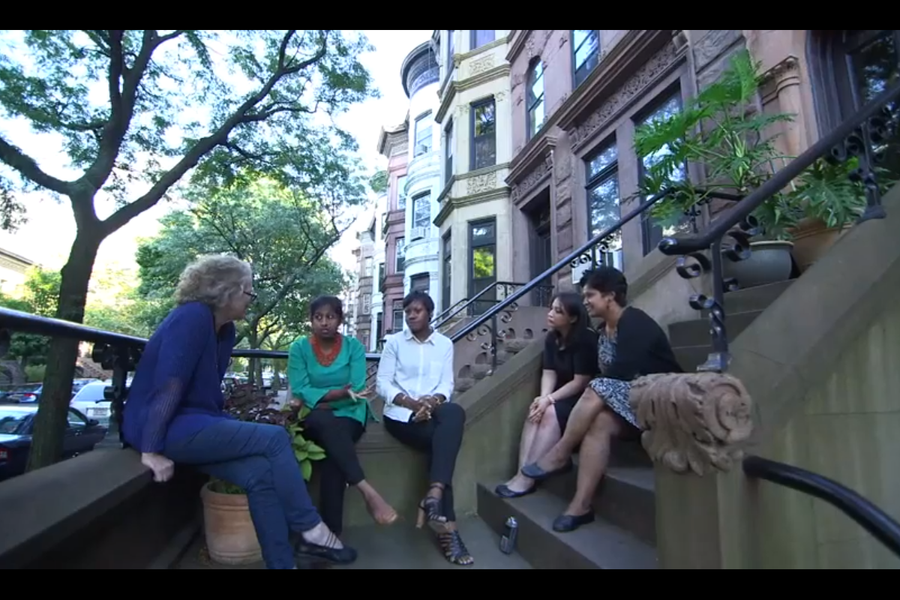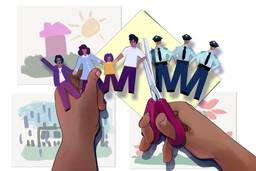A Case for Couch Potato Feminism
An art exhibit meant to provoke face-to-face feminist dialogue disappoints.
Jude Ellison Sady Doyle

Between the Door and the Street is the sort of thing that makes you honestly wish you could grade art on its good intentions. The performance piece was created by Suzanne Lacy, an artist whose work is focused on feminism and the use of public spaces, in partnership with the Elizabeth Sackler Center for Feminist Art at the Brooklyn Museum. The premise — an entire street in Brooklyn, blocked off so that diverse groups of feminists can sit together and discuss their lives and beliefs publicly — was intensely admirable. The idea of getting over 400 women together to talk, face to face, rather than exchanging theory through writing or other long-distance means, was thrilling. The talent involved was formidable. But the execution, sad to say, didn’t bear out that promise.
The event was held on October 20: a cold, dismal afternoon, which (gratifyingly) didn’t seem to stop people from attending. The street was full enough that visitors had to wait in line outside of the gates. As I entered the space, odd ambient music and seemingly random snatches of women’s conversations played over a set of speakers. This was promising — I was intrigued to hear more, and random switching between the conversations could have been an interesting way to lend a unified voice to the project — but it faded soon upon entry. Instead, the exhibit was pretty much what it said on the tin: Groups of women in yellow scarves, having conversations on stoops up and down the street.
Without a unifying structure to synthesize the disparate conversations together, Between the Door and the Street had to live or die on the strength of the conversations themselves. And unfortunately, most of those conversations weren’t audible. There were no microphones at the stoops; audience members had to get close and strain to hear fragments of conversation over the crowd noise. If you happened upon a particularly popular conversation, you had to either fight your way to the front of the crowd (which seemed pretty incompatible with the warm, sisterly vibe the piece was going for) or give up.
Similarly, though I had high hopes of being able to tune into interesting and underrepresented perspectives — the press pack listed organizations ranging from Black Women’s Blueprint to Girls Against God to New Yorkers Against Gun Violence—there were no name tags for the participants or signs designating the different stoops. There were staff members outside of most stoops, bearing signs for their respective groups on their necks — which could have worked, with a smaller crowd in attendance — but the only way to learn about the organization in front of you was to locate a staff member and ask. This, it turned out, was less than ideal. In front of the Hollaback! stoop, I heard a woman asking for more information about the group.
“It’s an organization that fights, um, catcalls, and…” The staff member stalled out for a moment, clearly at a loss.
“It’s a feminist group,” she said, finally, as if that settled it.
Most of the groups assembled were “feminist groups,” depending on your interpretation of the term. Hollaback! is a grassroots organization that made waves by allowing women to document and photograph incidents of street harassment to create an interactive map of their cities. I’m not sure I could spit all that out in 15 seconds, and when I tried to explain the organization to the same visitor, I didn’t. But then, I wasn’t the sole source of official information for Hollaback! at the event.
Without attribution, a means of navigation, or a guarantee of hearing anything you wanted to hear, it turned out that the only real way to experience the project was just to float from one stoop to the next, picking up what you could at random. This process depended largely on luck. At one stoop, I heard a woman saying that she wished young people looked up to survivors of domestic violence; great! At the next, I heard a college student speaking about her life goals.
When she started complaining about people who made fun of her major — “They’ll say, ‘Oh, you’re majoring in English, hope you enjoy teaching,’ and it’s not funny” — I moved on. Unfortunately, I didn’t do any better at my next stop: That one featured a woman saying that she felt “truly empowered” when performing a slam poem about 9/11. “It was kind of political,” she confided to her group.
Well, yes. You would think.
I did catch flashes of real insight: “What I want to know is, what does it take for society to accept,” I heard a woman saying at my next stop. “Now that I’m out, and I have a criminal record, what does it take for society to accept me? It’s not about education, because I have two masters’ degrees.” An exhibition comprised of statements like that could have garnered a far different reaction. But trying to locate the no-doubt-plentiful insight was a fool’s errand.
Some of my reaction, I’ll admit, was based on privilege. I’ve spent the last five years of my life surrounded by feminists, hearing feminist conversations — something a younger version of myself, uneducated, frustrated, and isolated, would have killed for. And the exhibition hit a lot of the right notes: The participants varied in terms of age, race, and name recognition, which was a good nod to the decentralized, polyvocal experience that feminism can be at its finest. If I thought of the exhibit as something for entry-level folks, I could convince myself to feel more charitable. But I didn’t find many entry-level folks to justify it: Of the audience members I chatted to at the event, nearly all described themselves as feminists already (and complained about the lack of audibility). The only one who didn’t compared the whole thing to a “therapy group.” I was irritated by his dismissive attitude, and it’s worth pointing out that the consciousness-raising groups of the ’70s could also have been described as “therapy groups” by an outside observer. But if the point of the piece was to convert the uninitiated, well, I didn’t find any converts in the crowd.
The fact is, feminist conversations are already being had, and had very publicly. Cut-off, isolated young women of the sort I used to be do exist, but they have plentiful, well-known, free or low-cost options for getting connected. If you have an Internet connection — which, granted, not everyone does — you can tap into any number of conversations going on, from any number of well-known or more marginalized perspectives. There are, of course, benefits to having those conversations face to face; it tends to keep us in touch with the humanity of the people involved, something that Internet discourse is frequently lacking. But what Between the Street and the Door needed — and what I searched for, pretty desperately — was something that made it different, or better, than a panel discussion or a lively group blog or just a few hours spent on Tumblr. From what I could see on that one, rainy afternoon, nothing emerged to differentiate this experience from the many others I could have had if I’d just stayed home.
Jude Ellison Sady Doyle is an In These Times contributing writer. They are the author of Trainwreck: The Women We Love to Hate, Mock, and Fear… and Why (Melville House, 2016) and was the founder of the blog Tiger Beatdown. You can follow them on Twitter at @sadydoyle.








